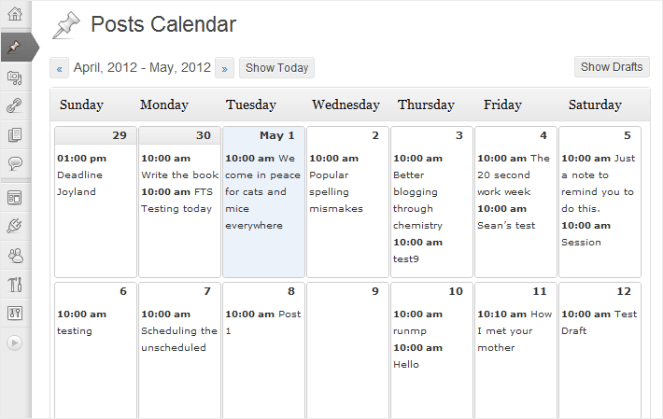
M any beginner bloggers wonder about how much content they should have ready when they launch their blog.
“How many blog posts should I start with? Do I need to have 10 posts ready? 1? None? What’s the right number?”
Ask any experienced blogger, and you’ll get a variety of answers. But they do agree on one thing when it comes to this question:
There’s a big difference between the ideal situation and reality.
Ideally, people will have planned a ton of content that’s ready to publish and more blog post ideas they can write in the future. In reality, most people write a whole bunch at the beginning because they’re excited about the new venture and then taper off.
To help you avoid these two extremes when you start your new blog, we summarized a few strategies you can use for your blog. Use them to create a solid foundation for it and create a great blog people will keep coming back to.
Ready? Let’s go.
In This Guide:
2 Ways to Launch Your Blog
When you start a blog, you’re probably excited about getting going. Most bloggers end up launching in one of two ways:
Launch Type 1 – Launch as Fast as Possible
- You just set up blog hosting, pick a WordPress theme that’s good enough, and get your blog “out there.”
- You write and publish a bunch of posts at the start and then taper off as you run out of ideas and energy.
- You publish a few more posts over the next few weeks but stop when you get caught up in tweaking your blog’s design. Or because you’re researching some new plugins that’ll help you monetize it in the future.
- You might even publish a few posts and taper off because you took a long time to write your third and fourth posts. That discourages you because you “think” you need to be publishing daily or weekly, so you give up and stop posting.
Launch Type 2 – Plan Your Blog Launch
You follow the advice of some SEO and blogging experts who say to have a whole bunch of blog posts to publish on launch day, a few drafts outlined, and a list of 20-30 post ideas lined up for research and writing before launching.
This can be a lot of work.
After all, writing a blog requires more than just brainstorming a few ideas. You’ve got to:
- Outline each blog post
- Find relevant stats or research for it
- Draft your blog post
- Weave in relevant keywords so you’ll get traffic from search results
- Insert images to make your posts visually appealing
No WONDER most people don’t do it all that when they launch their blogs!
Successful bloggers will have done both of these strategies and more. They’ll tell you they wished they’d taken the time to plan out their launch to build a successful blog that was sustainable right from the start. And others will tell you that they wish they would have launched their blog sooner instead of writing a ton of content beforehand.
But don’t worry, there is a middle ground…the Ideal Blog Launch.
What’s the Ideal Blog Launch Plan?
The ideal blog launch includes the right combination of topic research, keyword planning, and blog post work.
With the right planning, you’ll have set up a solid foundation for your blog. You’ll create and publish new blog posts easily and regularly, optimize your site for search, and grow your audience.
We don’t recommend launching your blog with zero content. But, you don’t need 20 blog posts ready to go either.
So, how many articles do you need to start a blog?
We recommend writing 3-5 posts before you launch so you’ve got something for people to read right away.
This will also give you time to brainstorm more ideas and get a sense of how long it takes you to write each post.
For more help in creating that content for your blog launch, we’ve created a checklist for you. It’ll help you with that initial few posts and keep you moving forward so you’ll publish consistently in the future.
How to Create Enough Content to Launch Your Blog (A Checklist)
Use this checklist to create enough content to launch your blog the right way and keep you writing fresh content regularly.
1. Brainstorm 30 Post Ideas

First, take 10 minutes and come up with 30 blog post ideas.
How?
You can:
- Take your first idea and put a few spins on it. E.g. The idea “10 Ideas for Meatless Dinners” can turn into “10 Ideas for Meatless Breakfast”, “10 Ideas for Meatless Shareable Dishes”, and “10 Ideas for Meatless Dinners You Can Cook in Less Than 30 Minutes.”
- Take one of your ideas and come at it from the opposite side of it. E.g. Turn “5 Better Ways to Be Productive” into “5 Mistakes You Make When Starting Work.” Or vice versa.
- Open Google and let it suggest new ideas to you. Type your blog idea into the search box and see what auto-complete options it gives you.
- Next, complete the Google search and scroll to the bottom of the page to check out the “Searches related to…” list. These are related topics people searched for, meaning they’d be a good idea for a post.
- Look at a few of your competitors to see what they’re writing about and come up with your spin on similar ideas.
- Check out what everyone’s sharing or talking about on social media.
If you have trouble coming up with 30 ideas, it’s probably not a good idea for a blog niche. It might be too narrow, there might not be enough to write about, you’re not passionate about the topic, or you don’t know enough about it.
After you come up with 30 topics, keep this list handy going forward as you’ll add to it whenever you come across a good idea.
2. Write 3-5 Posts Before You Launch
Now it’s time to write your first blog posts. Take a few of the ideas you just brainstormed and work on them. Write each post one at a time so you don’t get overwhelmed.
Remember, these first posts don’t have to be anything special. They don’t have to be letter-perfect or introduce you and your blog. Write content that fits your niche and overall blog theme and serves your future audience.
If your blog has a few categories, make sure to write at least 1 post per category before you launch. This will give people a taste of the different topics you’ll be publishing regularly. If they’re interested in the topics, it will encourage them to come back.
You’ll publish these posts before you launch, so they’re ready to go when you do launch. You can do this one of two ways:
- Publish them right now and turn off the search engine visibility option in WordPress. In your WordPress Admin panel, click Settings » Reading and select the Search Engine Visibility option. When you’re ready to launch your blog, clear this checkbox, and search engines will start to index your site.
- Schedule them to be published automatically on your launch date. Read this post to learn how to schedule posts in WordPress. You set the date and time, and that’s it! Your site will publish them automatically for you.
Be sure to create social media messages you can send out when the blog posts go live too. After all, social media can help drive traffic to your blog and boost engagement with your readers.
Each social media platform has different requirements for images, hashtags, message length, and more, but generally speaking, you’ll need: a good message, relevant hashtags, and an engaging image.
Here’s a great example from the food blog, My Creative Expression:

Online tools like Canva have templates that make it easy to create social media images, while a scheduling tool like Buffer Pro can help schedule your posts in advance and save you time.
3. Draft 5 Posts But Don’t Publish Them

There’s a lot more to being a blogger than merely writing and publishing posts. As you’ve seen from setting up your blog, there’s the technical side, your social media marketing, and engagement with your audience.
That’s why having a few posts ready to go as drafts is vital before you launch. Those first days and weeks will be busy as you get the hang of it all. These drafts make it easier to publish new content during the busy launch time. You’ll stay ahead of your content calendar (more on that next) and you’ll be able to create content stress-free.
What you’re aiming for with a new blog is consistency. Publishing regular posts signals to Google that you’re a live blog managed by someone all the time. It boosts your posts in the search results, which is important at the start. Your blog has no history with search engines, and this helps you establish it.
Just outline the posts, maybe add some links to research you’ve already done on the topic, and save it as a ‘draft’ in WordPress. When you’re ready to work on it, pull it out of draft, write, and publish it.
4. Create a Content Calendar
A content calendar is a list of posts and dates of when you’ll publish them. Some bloggers get fancy and use a WordPress plugin to track it, but even a paper calendar will do. Creating one now will take the pressure off you when it comes time to write your next post. You’ll already know what to write about when you sit down at your computer.

It also helps you create content in a more thoughtful way for your readers, building on themes and ideas from one post to the next. Your content will take readers on a journey instead of being one-off posts they read whenever they remember.
Plus, you’ll be more consistent with your calendar and disciplined to write and publish it if you have a plan laid out. Remember, Google loves fresh content, so how often you publish matters to your search engine rankings.
So, to keep on-track for how often you should blog – take a calendar and plot out the posts you’ll write each week. We recommend you start by publishing once a week, so you develop the habit of writing regularly, and the Google search bot comes more frequently to your new blog. It’ll help get it indexed by search engines and showing up in search results.
To create a content calendar, you can use:
- The Editorial Calendar WordPress plugin as shown earlier
- An online calendar with Google Docs, your smartphone, or tablet
- A paper calendar near your desk or computer
By this point, you’ll have created enough content to launch your blog and get it out there. You’ll also have set up a solid foundation that’ll keep you writing regularly so you can steadily grow your blog with each post you publish.
But is there anything else you need ready when you launch your blog besides a few posts and ideas for more?
What Else You Need to Have Ready When You Launch Your Blog
As a blogger, you’ll be busy writing and publishing articles on your site. As a site owner, however, there are a few things you need to stay on top of right from the start.
Handling or thinking about these things now will save you headaches in the future and set up your blog to be a financial success if you’re interested in making money with your blog.
Here are a few things to think about:
- What’s your end goal for the blog? Make money? Create a community? Share your story? This will help guide your content planning for future posts.
- How much money does it cost to start a blog? While planning your launch, check out our guide to ensure you stick to your budget.
- Did you choose the best WordPress theme for your blog? First impressions are important, so be sure to choose the right theme.
- What security issues do you need to worry about with your WordPress blog?
- How can you monetize your blog? With this guide, you can start making money from your blog right away.
- What SEO tips can help you right now? Optimizing for SEO will help you drive more traffic to your blog early on.
- What WordPress plugins do you need to grow a successful blog?
These questions will help guide your blog’s progress and ensure you’re taking care of all the extra things owning a blog entails. This list is by no means exhaustive, but it’s a good starting point.
Now that you know how many posts you need to launch a blog, are you ready to jump in? The success of your blog depends on your words and the work you put into it. We hope this post has taught you how much content you need to launch so you can set up your blog for success from the start.
For a deeper dive into a blog launch, check out our post on the 47 things you need to do before launching a blog and best blogging platforms.
And don’t forget to sign up to our email newsletter to get the latest blogging tips and updates!


Wow, this is really interesting and very useful post, thanks for sharing.
Thanks for making such detalied e book on blogging . every one should try this !
The editorial wordpress plugin has been my go-to tool for years! Not a fancy app, just a good workhorse that gets the job done. Nice stuff.
This is what I have been looking for straight to the point and super informative for a first time blogger! Thanks great work!
Really interesting post..keep posting more…
Found your article very interesting. The frequency of blog posts does matter especially when you are a newbie.
Such a helpful blog post 🙂